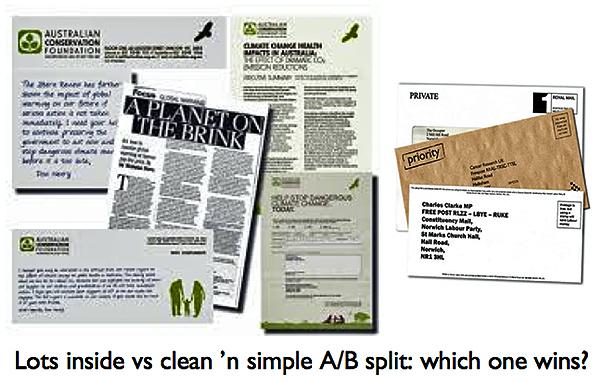Musings of a direct response fundraiser no. 1: revisiting the basics
In this first article in a new series focusing on what you really need to know about direct marketing for fundraising, seasoned Australian fundraiser Jonathon Grapsas sets out some of the direct-mail basics. They might surprise you… Next, watch out for future features from Jonathon coming very soon on SOFII. Articles in the pipeline include: ‘Asking: finding the sweet spot’ — on the science of testing; ‘Tell me again, stupid’ — about why repetition pays; ‘Why more wins’ — about stuffing your packs with shed loads of extra bits.
- Written by
- Jonathon Grapsas
- Added
- September 23, 2014
I remember distinctly arguing with a colleague about the merits of long fundraising letters. Surely not, I contested. I knew my direct marketing and, having spent some time using the telephone to raise money, I was adamant that short, succinct letters work best. They did to confirm the outcome of a telephone call anyway. Us ‘phone folks’ knew more than those pesky direct-mail types. Right?

My argument was flimsy at best, shot down in a flurry of empirical evidence: data proved that long fundraising letters, if crafted well, beat their shorter equivalents, hands down.
It was a slap in the face, harsher than any ice-bucket challenge. It provided me with an important lesson in direct response fundraising: one of the lessons that I live and breathe to this day.
Fundraising is often counter-intuitive
The work we do is littered with examples that our gut says simply don’t make sense.
Giving people lots of choice is a good thing. No, it is not, choice paralyses. Asking people to do one thing only will almost always generate a better result than giving them lots of choice.
Our supporters want us to be thrifty. Don’t spend a lot on those mail packs, please. They think they do, but they really don’t.
Which segues nicely into lesson number two.
We are a fickle bunch. What we say and do are two different things.
- A roomful of your donors is sitting down and you’ve shown them two direct- mail packs. One is chockfull of stuff, a four-page letter, three supporting pieces, a full-page response form, reply-paid envelope, the ‘works’.
- The other includes one-half page letter and a tear-off response form attached.

- Overwhelming response: ‘The best use of your money is the “small” pack. Don’t waste money on the “big” pack. We wouldn’t respond to that.’
- Wrong. You have, and you will.
- Your donors will tell you through their actions, as opposed to their words, whether something you produce works or not. Asking supporters their contact preferences by way of focus groups and surveys is fraught with danger – they’ll tell you what they think they want. Or what they think you want to hear.
- It’s not malicious in any way, in fact the opposite. They want to do good, but their method is often misguided.
- The point is: use split testing to determine whether something works. Just because your donors told you they won’t respond to it in no way means they won’t.
- Sadly, most of us won’t test. Roll on lesson three.
People are inherently lazy
This point refers to fundraisers and donors.
Fundraising is difficult enough without providing hurdles for donors to jump over. Affixing a stamp to a reply-paid envelope, squinting to read a tiny font on a response form, having to decide between different ways to support.
They may seem fairly innocuous tasks to do but all lead to indecisiveness and apathy.
Make your donors’ lives easy. As human beings we are lazy. Don’t give me an excuse not to help you. Provide a stamp, make the font minimum 12 point and just ask me to do one, simple thing.
I am baffled daily by the lack of direct-response testing that fundraisers do, or don’t do. When I ask someone I’ve just met about the health of her or his programme at some point the conversation leads to testing. For example, I expect every fundraiser to know the ‘sweet spot’ for asking for cash within their appeals. Most do not.
‘What testing have you done?’ Insert blank stare/awkward silence.
I expect every fundraiser to know the ‘sweet spot’ for asking for cash within their appeals. Most do not.
Do you know whether a highest-gift ask beats an average-gift ask at Christmas. What proportion of your last cash gift determines how much your monthly-giving ask is? Do you know how many personalised asks should be included within an appeal letter.
The only excuse for not knowing these things is not having a large enough sample size to test. In this case, research and find out what has worked for others. Despite what you may think, your supporters will behave the same as your friends up the road.
So,
yes, what works for other organisations will almost certainly work for you. Enter lesson four.
Old can be shiny
- Speaking of ice buckets, I may just tip one over the head of the next person who tells me they want to ‘do something creative and innovative’ with their DM programme. They’re ‘tired of the same old’. They’ve been bought in to ‘shake things up’.
- Meaningless drivel.
- If I were a direct marketer in a new role the first question I’d ask my colleagues is ‘where’s the test library’? The disciplinarian in me would look to ensure every piece of valid testing undertaken had/has been rigorously applied to improve the performance of my programme.
- I can hear you yawning. Boring, yes, effective, most definitely.
- It’s like the argument you have with your dad about how football these days is so much better, the athletes far superior, the goals scored so much more difficult. We, wrongly, assume that because something is older it can’t be as good. Everything’s much shinier these days.
- At this point it’s worth remembering the argument with my colleague about long letters. That was a decade ago. Three months ago I tested the length of a letter for the umpteenth time and the result was: long wins, again. Think about it.
Now time for lesson five.
- Revisit lessons one to four: repeatedly.
© Jonathon Grapsas 2014





















